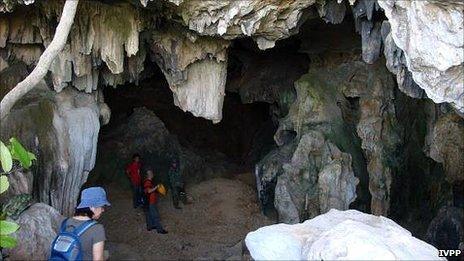Early date for Chinese human fossils
- Published

Scientists say the chin is distinctly modern in form
Modern humans could have reached East Asia much earlier than believed, according to new evidence.
An international team analysed fossil teeth and part of a jaw unearthed in southern China in 2007.
In the journal PNAS, the scientists say the fragments belonged to a "modern" human who lived 100,000 years ago.
The study is likely to be controversial: the earliest humans previously known from East Asia were half this age.
Wu Liu from the Chinese Academy of Sciences led the predominantly Chinese team that worked at Zhirendong (Zhiren Cave) fossil site.
US scientist Erik Trinkaus from Washington University in St Louis and R Lawrence Edwards from the University of Minnesota in Minneapolis also took part in the study.
Living together
Dr Trinkaus explained to BBC News that the ancient remains mean modern humans co-existed with our closest relatives - Neanderthals and Neanderthal-like people - across Asia.
"There are some archaic features in the specimen and that suggests to us that these are not just simply modern humans coming out of Eastern Africa, but somewhere along the way they probably intermixed with regional groups of archaic humans," Professor Trinkaus told BBC News.
"Previous evidence for co-existence was basically between Europe and Western Asia and adjacent part of Africa, but what this suggests is that the geographical range of co-existence spread all the way across Asia, which is an enormous difference.
"This is the first evidence for that."
The remains were spotted by scientist Chang-Zhu Jin during excavations at a site in Southern China.
The researcher was able to distinguish the valuable fossils among "the bones of a whole bunch of other mammals from a little over a 100,000 years ago".
Professor Trinkaus said that in terms of human evolution, the remains showed distinctive modern human features - a lower jaw with a distinctive chin.
"That means that modern humans spread across at least southern Asia some 100,000 years ago," added the scientist.

The fossils were discovered at Zhirendong in southern China
"It is interesting because we get the persistence of archaic humans, pre-modern humans, further north across all of Eurasia for another 60,000 years.
"It means that there was something that allowed these modern humans to spread across southern Asia, but at the same time they weren't able to spread further north across Asia or into Europe - they did not [have] this overwhelming superiority that is sometimes attributed to modern humans since they clearly didn't spread across all of the old world at this time period."
Possible controversy
Professor Fred Smith of Illinois State University reviewed the paper for PNAS journal. He said that it was possible such a significant discovery could generate controversy.
"It will remain somewhat controversial because it's only one specimen at one site, but the fact is that it is a very important piece of the puzzle," he told BBC News.
"There's always a possibility that a date is wrong or that something has gone wrong. I don't see any [such] indication, but there's always a possibility of complications that weren't noticed or weren't completely understood.
"I'm sure that there will be some controversy, some people that are going to say: 'Well, this is all well and good, but we need more information to be certain'."
To make sure the study is correct, Professor Smith said scientists will continue their efforts to find more specimens of modern human fossils from southern China.
- Published27 August 2010
- Published20 September 2010
- Published26 August 2010